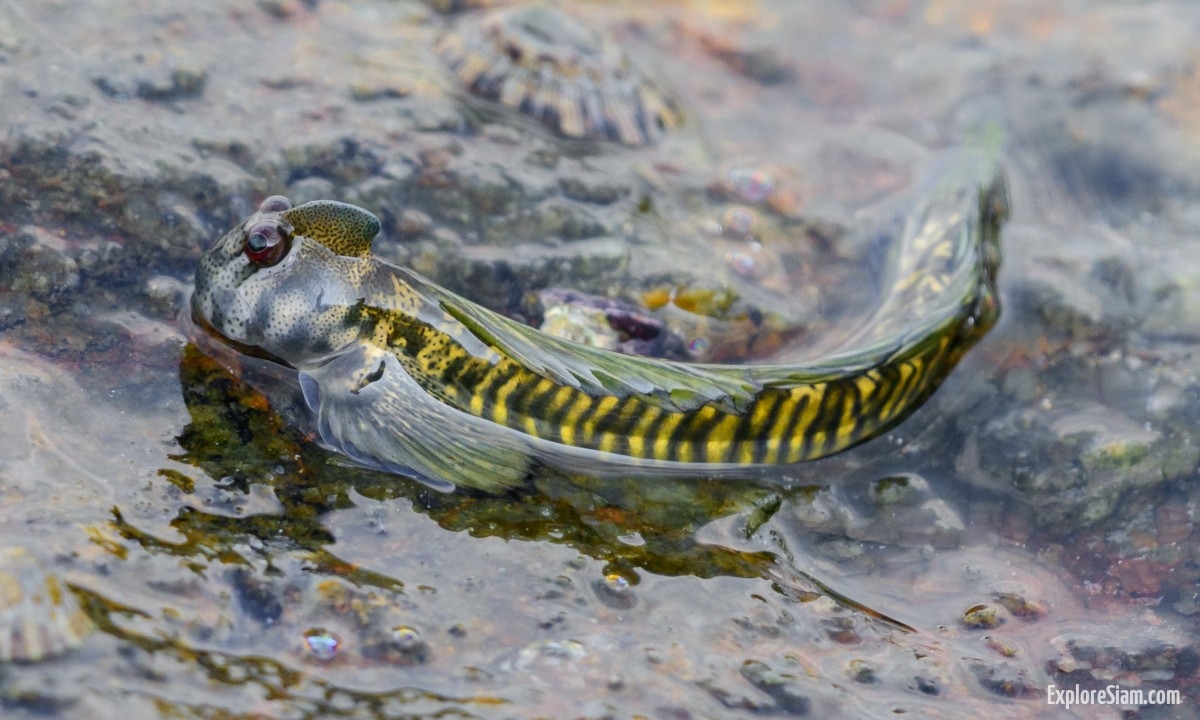In the world of nature, few creatures capture our imagination quite like the mudskipper. A fish that walks on land might sound like something from a science fiction tale, but for mudskippers, it’s their everyday reality. Found primarily in the mangrove swamps and mudflats of Southeast Asia, Africa, and Australia, these remarkable fish are a marvel of adaptation. But what makes them so fascinating is not just their ability to breathe air or move across the muddy landscape — it’s also their playful behavior and unique, often adorable appearance.
A Fish Out of Water
At first glance, the mudskipper may seem like an ordinary fish, but it holds secrets that challenge our understanding of aquatic life. Mudskippers spend a surprising amount of time out of the water, walking, hopping, and even climbing up grass blades and roots. They often share their muddy habitat with crabs, darting and leaping alongside these crustacean companions. Watching mudskippers interact with their surroundings is endlessly entertaining, as they flick mud, jump with surprising agility, and sometimes engage in small territorial disputes.
One of the most charming aspects of the mudskipper is its appearance. Its slightly flattened head and narrowly set eyes give it a curious, almost comical look. These eyes are among the mudskipper’s most distinctive features. Positioned on top of their head, the eyes can move independently, allowing the fish to keep a lookout for predators and potential mates while exploring their environment. The mudskipper’s expressions are remarkably animated, and their unique eye movements are a joy to observe.
Life on Land: Breathing Air
The ability of mudskippers to live out of water for extended periods is one of their most fascinating characteristics. Unlike most fish that are confined to aquatic environments, mudskippers are equipped to breathe air. They do this through two mechanisms: by absorbing oxygen through their skin and the lining of their mouth and throat when they’re wet, and by using special chambers in their gills that retain water and keep them moist. This dual system allows mudskippers to thrive in intertidal zones, where the water comes and goes with the tide, and sometimes disappears altogether.
While walking on wet mud might seem challenging for a fish, mudskippers have developed a method of movement that is almost amphibious. Using their strong pectoral fins, they pull themselves along the mud, much like a small creature would crawl across the ground. They can even perform short, powerful jumps, allowing them to navigate the uneven and slippery terrain of the tidal flats. This behavior is not just functional; it’s also a charming spectacle for those lucky enough to witness it.
Diet and Feeding Habits
Mudskippers are primarily carnivorous, and their diet consists of small insects, worms, and crustaceans they find in the mud. Their ability to leap and explore the shorelines gives them access to a wide variety of food that many aquatic species can’t reach. They use their powerful mouth to suck up food, and sometimes you can spot them munching on a small snack between their jumps and dashes across the mud.
Despite their size, mudskippers are surprisingly effective hunters, and their ability to thrive in environments that are challenging for other species has made them a dominant force in many mudflat ecosystems. Observing their feeding behavior provides a window into the delicate balance of life in these unique habitats, where every creature has adapted in its own way to survive.
Playful Personalities
One of the reasons mudskippers are so beloved is their playful personalities. Unlike many fish, which may seem passive or detached, mudskippers are interactive creatures. They often engage in curious behaviors, like climbing small plants or grass stems to gain a better vantage point or hopping over puddles to explore new territories. These behaviors make them incredibly endearing to those who watch them in their natural habitat. It’s as if they are constantly discovering the world around them, and their antics often draw comparisons to more familiar terrestrial animals.
Mudskippers are also social. While they can be territorial, they frequently share their environment with other mudskippers and crabs, forming small, bustling communities on the muddy flats. In these gatherings, you’ll see plenty of activity: chasing, jumping, and sometimes even mock battles between individuals vying for the best spots.
Unique Adaptations
Beyond their amusing antics, mudskippers are a showcase of evolutionary adaptation. Their modified fins allow them to walk on land, but they’ve also developed other traits to survive both in and out of water. Their eyes, perched on the top of their head, allow them to scan for danger while submerged or above ground. This gives them a significant advantage in detecting predators or rivals while their bodies remain safely hidden in the mud or shallow waters.
Their ability to breathe out of water, though extraordinary, has its limits. Mudskippers must remain moist to facilitate gas exchange through their skin, which is why they stay close to water sources. The constant interplay between water and land makes their environment both a challenge and a playground for these agile fish.
A Mudskipper’s Legacy
Mudskippers are one of nature’s most extraordinary oddities, a species that defies traditional definitions of what it means to be a fish. Their ability to walk on land, breathe air, and display playful, intelligent behaviors has made them a favorite subject for researchers and nature lovers alike. Whether they’re hopping through the mud, interacting with crabs, or climbing a blade of grass, these little fish are a reminder of the incredible diversity and adaptability of life on Earth.
In the wet, muddy world of the mudskipper, there’s always something fascinating to see — whether it’s their curious expressions, their daring leaps, or their survival in a habitat where land and water blend together in a delicate dance.





